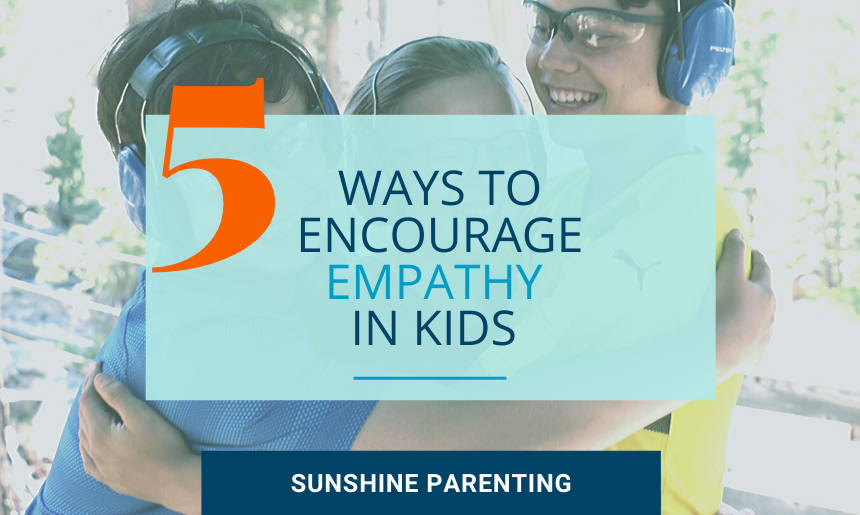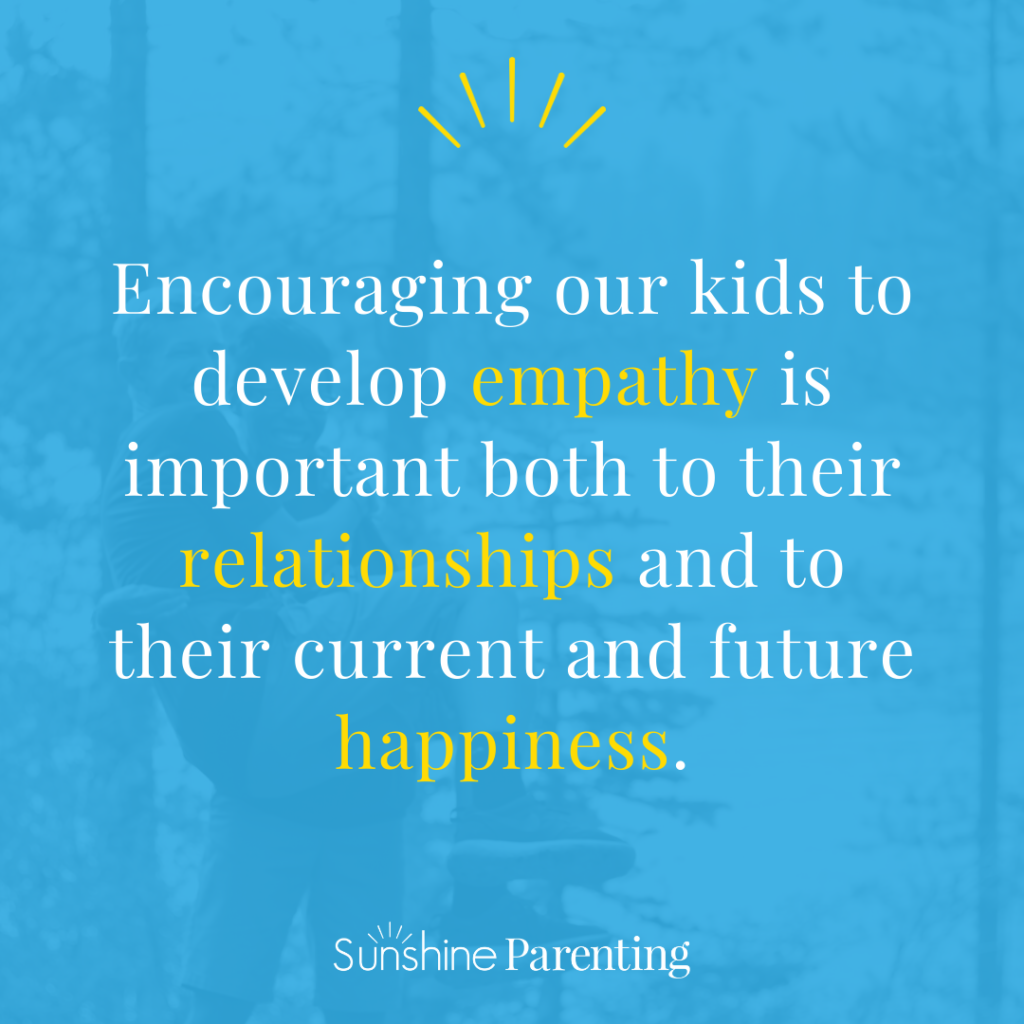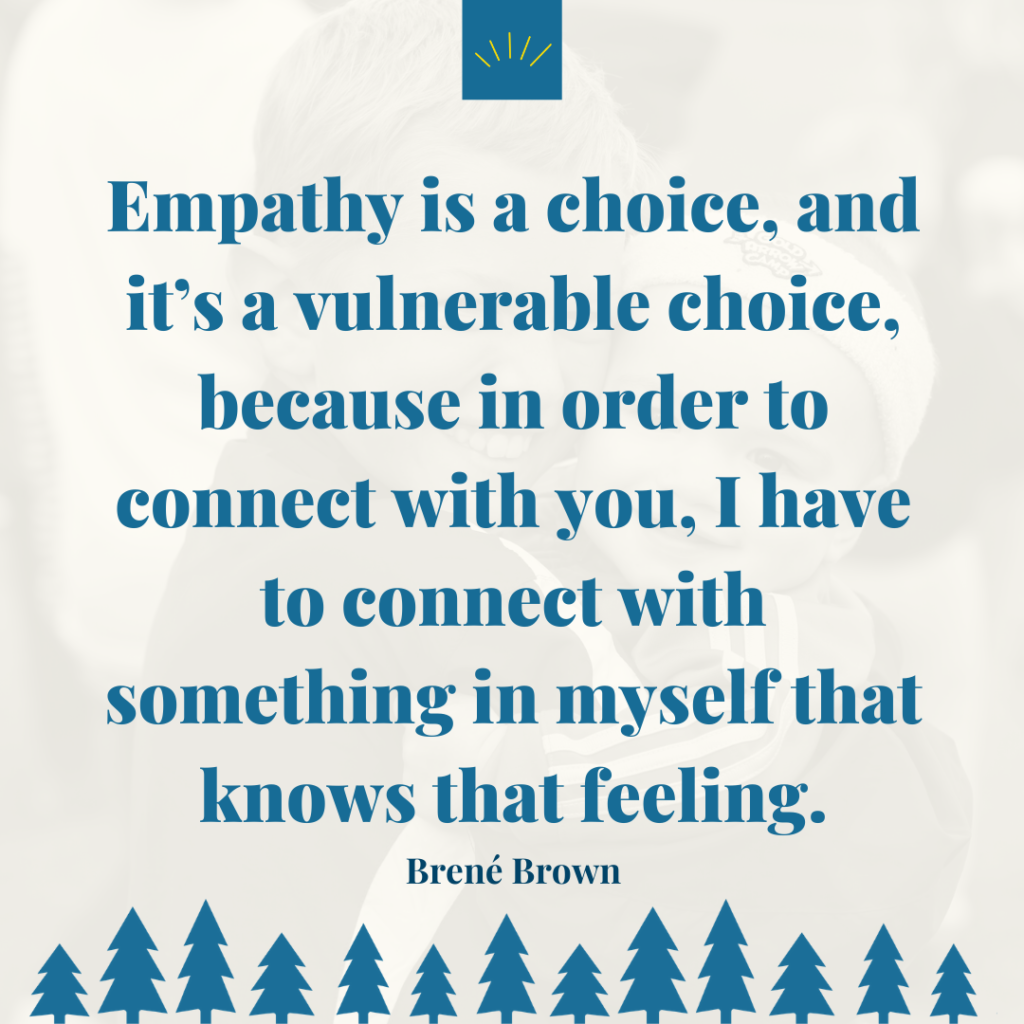
Sometimes we need someone to simply be there. Not to fix anything, or to do anything in particular, but just to let us feel that we are cared for and supported.
Brené Brown
Why is Empathy Important?
Of the skills required to have positive, lasting relationships, empathy is one of the most important and one of the hardest to acquire. Empathy is an important part of Emotional Intelligence and includes both our ability to recognize, understand, and manage our own emotions as well as the ability to recognize, understand, and influence the emotions of others.
In an increasingly divided, angry, and polarized culture, empathy is a character trait rarely on display among adults, but one we must encourage in our kids if we want them to thrive.
Thriving adulthood requires excellent relationship skills, and empathy is fundamental to positive, close relationships. In positive relationships, we feel as happy for our loved one’s achievements and victories as if they were our own. We feel their positive emotions. Likewise, we feel their pain and suffering when they experience failure, illness, or tragedy.
For approximately 20% of the population (those who meet Elaine Aron’s Highly Sensitive Person description), empathy comes naturally. According to Aron, these people (kids and adults) “display heightened awareness to subtle stimuli – whether positive or negative – and process information more thoroughly.” ‘“Sensitive people” show heightened activity in empathy-related brain regions That heightened awareness includes being more aware of and sensitive to other people’s emotions.
But how do the rest of us (the other 80%) build our empathy muscles?
The same way we build all social and emotional skills: through learning and intentional practice.
Encouraging our kids to develop empathy is important both to their relationships and to their current and future happiness. Empathy fuels connection.

What is Empathy?
Perhaps the best definition of empathy I’ve heard comes from (of course) Brene Brown.
Other definitions of empathy I find helpful:
The ability to understand and share the feelings of another; feeling with people.
Noticing, showing up, and joining the other person in their experience (without fixing, rescuing, or solving).

Sometimes we struggle with how to respond to a friend who’s in emotional pain, but Brown gives us words that communicate empathy: “I don’t even know what to say right now, but I’m just so glad you told me.”
For those of us who are talkers and problem-solvers who want to jump in with a solution, Brown reminds us that, “Rarely can a response make something better. What makes something better is connection.”
On the Skills You Need website, they distinguish three different types of empathy:
Cognitive (perspective-taking)
Emotional (feel the other person’s emotions)
Compassionate (feeling someone’s pain & taking action to help).
Ways to Encourage Empathy in Kids
#1 Talk about What Empathy is
Use kid-friendly words when teaching your child about empathy.
Some examples:
showing that you care;
being there for someone else;
looking at things from their point of view;
being sad with your friend; and
being happy with your friend.
The most important aspect of empathy for young children to understand is that showing up with a hug, a kind word, or a chocolate milk is enough.
#2 Teach Your Child to Respond with Empathy to Other Kids’ Bad Behavior
Learn to temper your own response to other kids’ bad behavior. Instead of getting upsetting and jumping in to rescue mode, respond with curiosity. Ask your child, “What might have caused him to act that way?” Conflicts between kids are another opportunity to teach them empathy. One of the greatest benefits of empathy is being able to consider the other person’s point of view when resolving conflicts or figuring out a compromise. We want our kids to start asking themselves, “Can I try to see what happened through the other person’s point of view?” so we need to ask them (about the person they are in conflict with), “What do you think she is thinking/feeling? What does this situation look like from their point of view?”
When other kids behave badly (saying or doing something unkind or rude), view the situation as an opportunity to develop your child’s empathy.
#3 Model Empathy
Model for your kids showing up and doing something kind to celebrate or mourn with others. Give hugs, write notes, bring a meal or gift, be with the person.
#4 Play Games
Play games that teach empathy. For example, “Name That Emotion”: Learn to read facial expressions and practice making faces/recognizing what they mean. “Our ability decode faces is very important, and may be linked with several measures of success and social competence.” Gwen Dewar, Ph.D., Deciphering facial expressions for kids: Can we help children read emotions?
I keep links to tons of games and activities to help kids with social skills on my Social Skills & Friendship Pinterest Board.
A few empathy activities I linked to on Pinterest include:
Empathy Scenarios, Proud to Be Primary (scroll to Social Emotional Activity #6!)
Empathy Puzzles, Teachers Pay Teachers (Counselor Chelsey)
The Empathy Map, Hope for Hurting Kids , Wayne Stocks
There are tons of games and resources available to teach empathy, many of which are on one of my favorite sites, Teachers Pay Teachers! Check them out if you want to find one that works for your family or the age group of kids you work with.
#5 Discuss Stories, Situations & Responses
Talk about hypothetical or real-life situations and ask your child how he or she thinks another might feel. Ask your child, “How would you feel if that were you?” Then ask them how they might respond and discuss with them ways they may be able to help.
When you read stories or watch TV shows or movies, talk about the characters’ experiences and feelings. “Fictional stories and real-life narratives offer excellent opportunities for teaching empathy and sharpening a child’s perspective-taking skills. What do the characters think, believe, want, or feel? And how do we know it? When we actively discuss these questions, kids may learn a lot about the way other people’s minds work” Gwen Dewar, Ph.D., Teaching Empathy: Evidence Based Tips for Fostering Empathy in Children
Last summer at camp, our summer theme was “Filling Buckets” and was based on Carol McCloud’s book, Have You Filled a Bucket Today?: A Guide to Daily Happiness for Kids. We talked all about filling each other’s buckets and understanding that each thing we say or do is an opportunity to fill or dip into others’ buckets. Even though it’s a simple picture book, the profound lesson is applicable to all ages.
Simply being more aware of opportunities to talk about how others might be feeling and how we can show up and support our friends and family members is the best way to start growing empathy in our kids and in ourselves.
Let me know your ideas for encouraging empathy in kids!
Resources used for this post
https://www.parentingscience.com/teaching-empathy-tips.html
https://www.parentingscience.com/facial-expressions-for-kids.html
https://www.skillsyouneed.com/ips/empathy-types.html
Related posts/podcast episodes
10 Friendship Skills Every Kid Needs
Ep. 80: The Emotionally Healthy Child with Maureen Healy
Ep. 2: 10 Friendship Skills Every Kid Needs
Ep. 41: Getting Comfortable with Discomfort with Christine Carter
